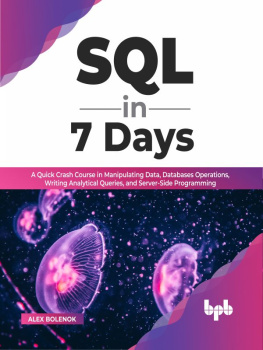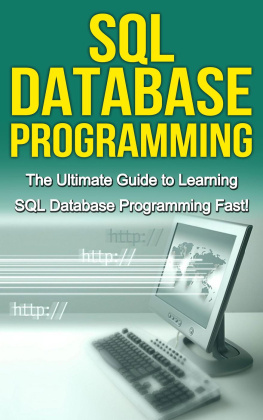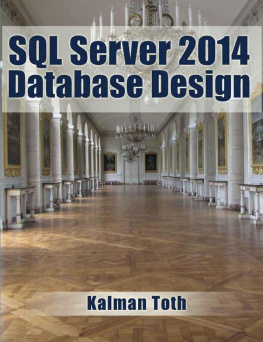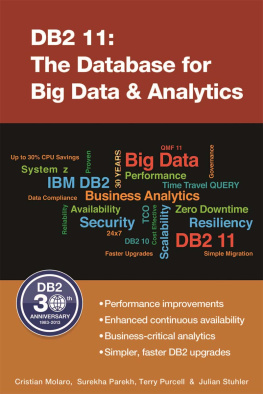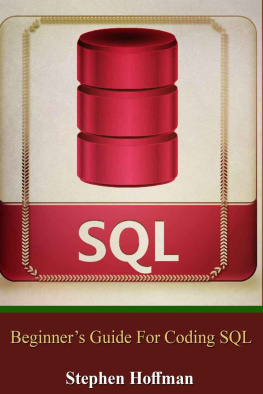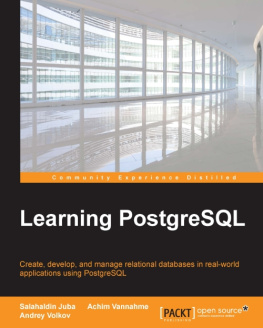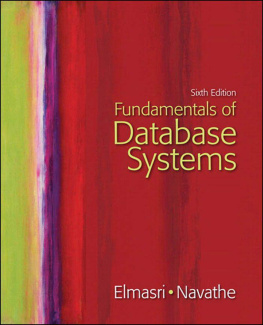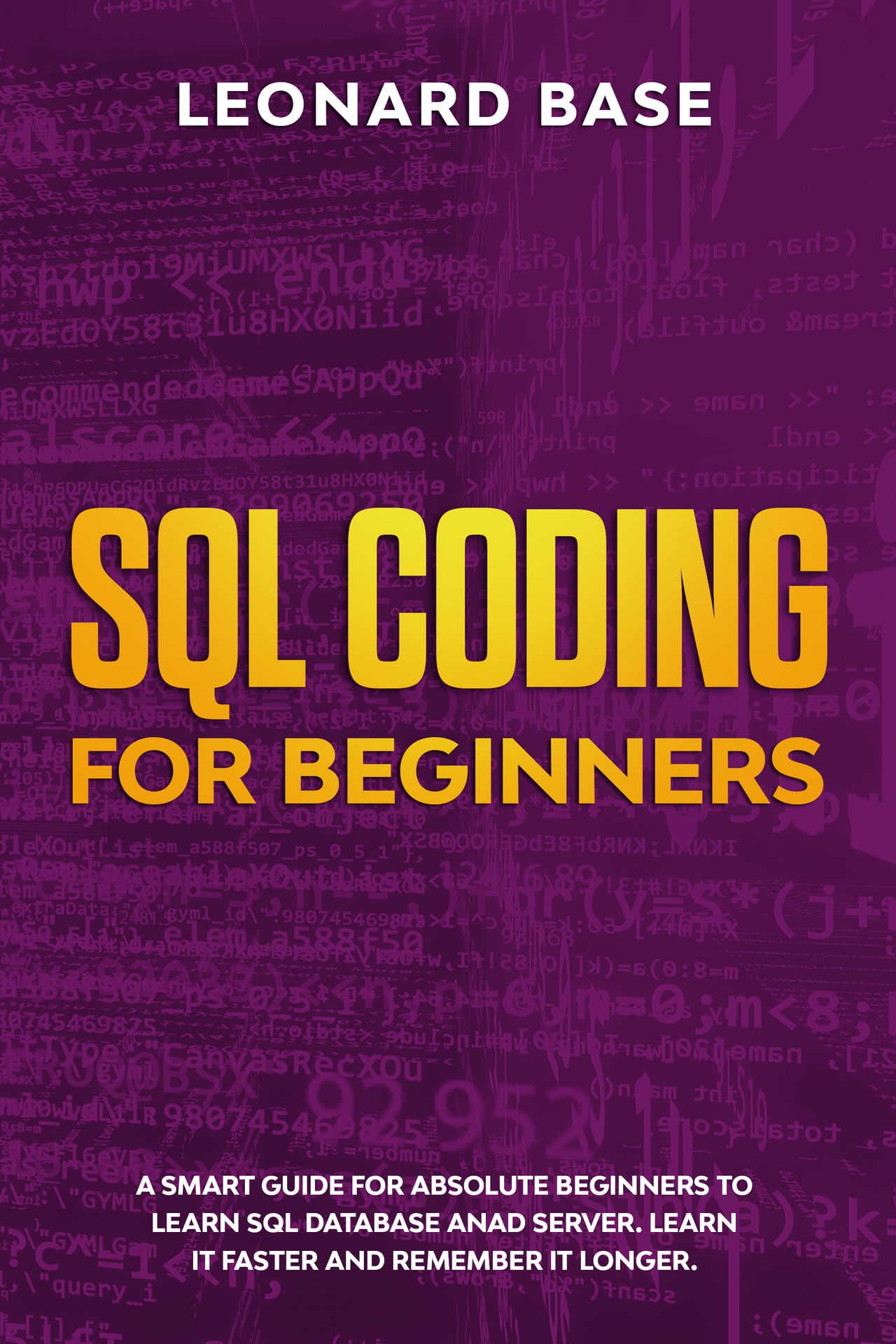Leonard Base - SQL Coding For Beginners: A Smart Guide For Absolute Beginners To Learn SQL Database And Server. Learn It Faster And Remember It Longer
Here you can read online Leonard Base - SQL Coding For Beginners: A Smart Guide For Absolute Beginners To Learn SQL Database And Server. Learn It Faster And Remember It Longer full text of the book (entire story) in english for free. Download pdf and epub, get meaning, cover and reviews about this ebook. year: 2020, genre: Computer. Description of the work, (preface) as well as reviews are available. Best literature library LitArk.com created for fans of good reading and offers a wide selection of genres:
Romance novel
Science fiction
Adventure
Detective
Science
History
Home and family
Prose
Art
Politics
Computer
Non-fiction
Religion
Business
Children
Humor
Choose a favorite category and find really read worthwhile books. Enjoy immersion in the world of imagination, feel the emotions of the characters or learn something new for yourself, make an fascinating discovery.

- Book:SQL Coding For Beginners: A Smart Guide For Absolute Beginners To Learn SQL Database And Server. Learn It Faster And Remember It Longer
- Author:
- Genre:
- Year:2020
- Rating:4 / 5
- Favourites:Add to favourites
- Your mark:
SQL Coding For Beginners: A Smart Guide For Absolute Beginners To Learn SQL Database And Server. Learn It Faster And Remember It Longer: summary, description and annotation
We offer to read an annotation, description, summary or preface (depends on what the author of the book "SQL Coding For Beginners: A Smart Guide For Absolute Beginners To Learn SQL Database And Server. Learn It Faster And Remember It Longer" wrote himself). If you haven't found the necessary information about the book — write in the comments, we will try to find it.
If you want to learn SQL fast and even if you have no technical skills whatsoever, Read On...
How many times have you thought about learning how to code but got discouraged because you had no technical background, didnt have the time to learn, or you just didnt think you were smart enough?
Well, we have good news for you.
You dont need an expensive computer science degree, a 500 page textbook or a genius mind to learn the basics of SQL!
Today our Digital lives have inundated companies with large volumes of data that is stored and maintained using the database management systems. One of the most widely used type of database management systems is called RDBMS or Relational Database Management System. Now, data storage is only touches the surface of capabilities expected from a RDBMS, the most vital functionality offered by these systems pertains to the ability of a user or company to not only organize and view the underlying data but also to make updates to the original data set while ensuring the security of this valuable data. This is where a programming language, such as, SQL is used to define, manipulate, control and query the data within a RDBMS.
This book will serve as your guiding beacon through the journey of learning a programming language for RDBMS, using a free and open MySQL user interface that can be easily installed on your operating system, so you can get hands-on practice and be able to create not only correct but efficient SQL queries to succeed at work or during job interviews.
Some of the highlights of this book are:
Learn the fundamental concepts of SQL language, along with the five fundamental types of SQL queries namely, Data definition language (DDL), Data manipulation language (DML), Data control language (DCL), Data query language (DQL) and a Transaction control language (TCL).
Learn the SQL CREATE statements and the vital concept of SQL constraints used with the SQL ALTER statements with hands-on exercises and examples.
Get familiar with are a variety of user interfaces available with MySQL servers including MySQL workbench, Sequel Pro, Toad, among others.
Get hands-on practice for creation of a whole new database and subsequently learn to create tables and insert data into those tables on the MySQL server.
Learn the concept of temporary tables, derived tables and how you can create a new table from an existing table.
Master the SQL SELECT statements along with the various data manipulation clauses including ORDER BY and WHERE.
Deep dive into the concept of joins presented with different SQL JOIN functions such as INNER JOIN, LEFT JOIN, RIGHT JOIN, CROSS JOIN and SELF JOIN.
Learn the MySQL UNION and MySQL UNION ALL statements are presented in detail along with the distinction between MySQL join and union functions.
Learn the CREATE VIEW statement is explained along with the underlying processing algorithms used in MySQL such as, MERGE, TEMPTABLE and UNDEFINED.
Master the concept of Updatable SQL Views with an understanding of how to modify SQL views using ALTER VIEW and CREATE OR REPLACE VIEW statements.
Deep dive into the concept of SQL transactions and various SQL transaction statements with controlling clauses such as, START TRANSACTION, COMMIT, ROLLBACK.
The syntaxes of all the SQL statement or queries are explained in exquisite detail, along with examples and pictures of the result set that you can expect to obtain while performing hands-on execution of the given examples on your own MySQL instance.
Even if you have no idea how to use SQL Programming, with this guide you can learn all the secrets to do it very quickly!
Want To Know More?
Download now and know all about SQL and what it consists of!Leonard Base: author's other books
Who wrote SQL Coding For Beginners: A Smart Guide For Absolute Beginners To Learn SQL Database And Server. Learn It Faster And Remember It Longer? Find out the surname, the name of the author of the book and a list of all author's works by series.

